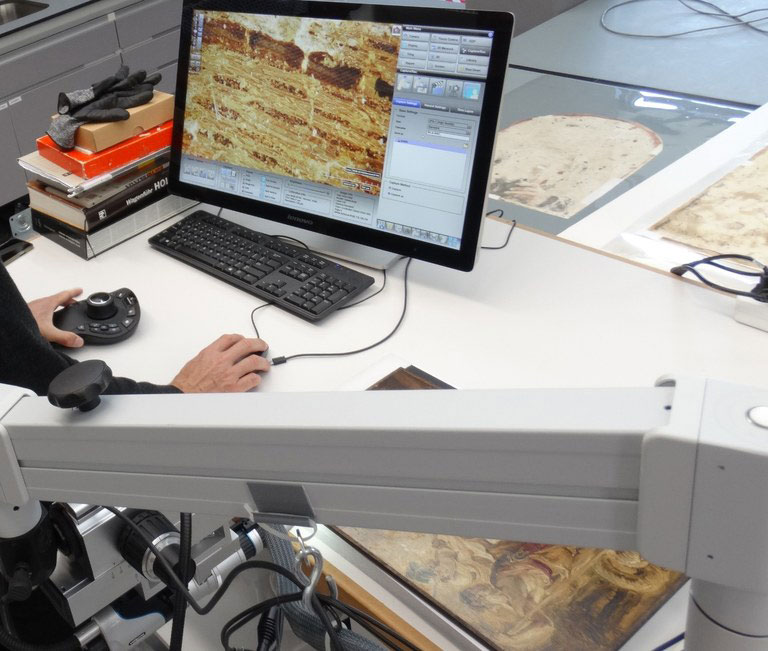by Marta Domínguez-Delmás (UvA), Francien Bossema (CWI), Erma Hermens (Rijksmuseum, UvA)
CT scans of a Rijksmuseum panel painting in CWI’s FleX-ray laboratory have revealed a surprising insight: it turns out it was not painted on oak, as was always assumed, but on tropical wood. The panel painting “Cadmus, Guided by Minerva, Observes the Spartoi Fighting” is a small oil sketch on panel attributed to an unknown follower of Peter Paul Rubens.
The CT scans were taken at CWI as part of a larger investigation into the history and origin of the painting. An interdisciplinary group of researchers from the UvA, the Rijksmuseum and CWI worked together to retrieve CT images of the wooden panel and date it using dendrochronology. The purpose of the CT scans was therefore to obtain a digital cross-section of the oak board and to visualize the tree rings. The tree rings could not be observed from the outside, due to oak strips attached to all sides of the panel. Dating the wood can provide crucial information for determining a production date, which in some cases can support or refute an attribution to an artist or a studio.

Figure 1: Painting in the scanner of the FleX-ray Lab at CWI.
The painting was taken to CWI’s FleX-ray laboratory for CT scanning. The CT images yielded a surprise as we observed that the support was made of two panels glued together. The original panel used for the oil sketch, is made of a tropical wood, whereas the back panel is made of oak. The tree rings of the oak board were perfectly visible in the CT images, and it was possible to date the panel to 1548 (last ring measured in the panel), with an estimated felling date for the tree after 1557 CE. However, this date became irrelevant, as the oak board was probably trimmed to meet the size of the original board and was glued to it at some point in time. The board used for the painting has been identified as probably Swietenia sp., a species seldom used in 17th-century Netherlandish workshops, but there are some early occurrences in the 1630s, Due to this wood type, we cannot establish through dendrochronological examination when the painting was likely made hence the panel remains undated. The oak board may have been added later for conservation purposes or with misleading intent, namely to pretend that the painting was in fact painted on oak, which would have been typically used in 17th-century Netherlandish painting, including in Rubens’ studio.
Non-invasive imaging techniques are rarely used for dendrochronological examination of art objects, despite the valuable information they provide. In this case, the CT scan was the key to discovering the two different panels and enabled dating of the oak panel. This research shows that implementing non-invasive imaging techniques to study artworks of different shapes and materials can be of great added value and can sometimes lead to so far not found new information.

Figure 2: Inspection of the panel painting.
Follow-up research
Because the painting was not painted directly on the oak panel, the established felling date is not indicative of the sketch itself. Many questions remain open for further research. The discovery that the oil sketch was painted on a tropical wood panel and not on oak as we all assumed, adds important new data but also raises many new questions about the dating and place of production and about the function of the panel. Hopefully, with research into the painting technique and materials, the story of this sketch can be further completed.
The painting
The panel painting “Cadmus, Guided by Minerva, Observes the Spartoi Fighting” (26.2 x 42.3 cm) is described as a copy after an original by Rubens (Private Collection, UK). The original sketch was the model for a larger painting executed by Jacob Jordaens, part of an ensemble of over 60 paintings Rubens was commissioned in 1636 to carry out for Philip IV, for the Torre de la Parada, Philip’s hunting lodge near Madrid.
Link:
YouTube video about the FleX-ray Lab at CWI: https://youtu.be/6Zjm_L-cXEc
Reference:
M. Domínguez-Delmás, et al.: “X-ray computed tomography for non-invasive dendrochronology reveals a concealed double panelling on a painting from Rubens’ studio”, in: PLOS ONE, 25 August 2021.
Please contact:
Marta Domínguez Delmás
University of Amsterdam, The Netherlands
Francien Bossema, CWI, The Netherlands
Erma Hermens, Rijksmuseum and UvA
The Netherlands











